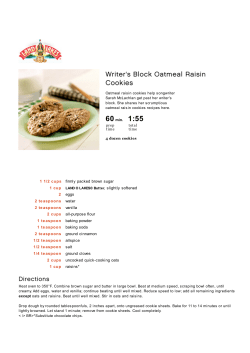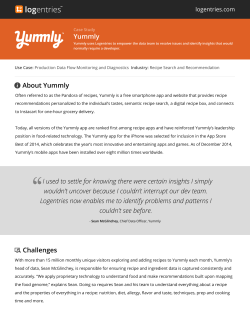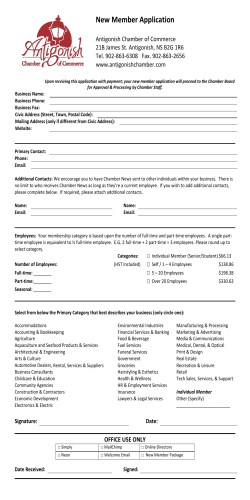
AST Cirie 200 Etcher - Hong Kong University of Science and
NANOELECTRONICS FABRICATION FACILITY (NFF), HKUST Standard Operating Manual ___________________________________________________________ AST Cirie200 Aluminum Etcher Copyright © 2014 by Hong Kong University of Science & Technology. All rights reserved. Page 1 NANOELECTRONICS FABRICATION FACILITY (NFF), HKUST Contents 1. Picture and Location 2. Process Capabilities 2.1Cleanliness Standard 2.2 Possible Etching Materials 2.3 Process Specification 2.3.1What the AST C200 CAN do 2.3.2. What the AST C200 CANNOT do 2.4 Etching Process Useful Information 3. Useful information to work in NFF 3.1 Emergency Responses and Communications 3.2Become a Qualified AST C200 User 4. Operating Safety and Rules 4.1 Operation Safety 4.1.1General Safety 4.1.2 Equipment Safety 4.2 Operation Rules 5. System operation 5.1 ICP-DRIE System Description 5.2 Initial Status Check 5.3 Initial System Check 5.4 Preparation before Etching Process 5.4.1 Gas Supply 5.4.2 Dilute Water Preparation 6. Introduction to ICP operation control system 6.1 Recipe page 6.1.1 Gas Flow 6.1.2 Pressure Copyright © 2014 by Hong Kong University of Science & Technology. All rights reserved. Page 2 NANOELECTRONICS FABRICATION FACILITY (NFF), HKUST 6.1.3 RF Power 6.1.4 Step 6.1.5 Helium Flow 6.2 Process page 6.2.1 Schematic 6.2.2 Process Data 6.2.3 Process Control 6.2.4 Transfer 6.2.5 Recipe Menu 6.2.6 Process Chamber Pressure 6.3 Alarm Page 7. Auto Process Run 7.1 Load lock chamber vent 7.2 Set substrate 7.3 Pump down and wafer loading 7.4 Run etching recipe 7.5 Chamber cycle purges 7.6 Wafer unloading and Load lock vent 7.7 Load lock chamber pump down 8. Process recording during the process 9. Clean up 10. Check out Copyright © 2014 by Hong Kong University of Science & Technology. All rights reserved. Page 3 NANOELECTRONICS FABRICATION FACILITY (NFF), HKUST AST Cirie 200 Aluminum Etcher 1. Picture and Location Fig.1 AST C200 Aluminum Etcher The AST C200 aluminum etcher is located at NFF Phase II cleanroom, Room 2240. 2. Process Capabilities 2.1 Cleanliness Standard The AST C200 aluminum etcher is being classified as SEMI-CLEAN equipment. Copyright © 2014 by Hong Kong University of Science & Technology. All rights reserved. Page 4 NANOELECTRONICS FABRICATION FACILITY (NFF), HKUST 2.2 Possible Etching Materials Aluminum and Aluminum–Silicon materials prepared in SEMI-CLEAN standard equipment. Titanium can only be performed on request 2.3 Process Specification The masking material can be photo-resist prepared in SEMI-CLEAN standard equipment. 2.3.1. What the AST C200 CAN do Individual 4 inches full silicon, glass or quartz substrate in at least Semi-Clean cleanliness standard. 2.3.2. What the AST C200 CANNOT do Substrate larger than 4 inches in diameter The metal films that not in the list. Defect appearance of the substrate. Fragile appearance of the substrate. Appearance of the photo-resist is not well baked. Appearance of the photo developer on the back side of the substrate. Substrate appears will generate particles during etching process. Sample with heat dissipation grease is not allowed. Dummy carrier wafer use must be in at least SEMI-CLEAN cleanliness standard. Special approval is required for substrate thinner than 400um. Special approval is required for incomplete sample (not full substrate). Film thickness of Titanium over 3000A. 2.4 Etching Process Useful Information In order to monitor the etching status through the attached LCD display, we recommended the etching mask should be in bright field. For aluminum film thickness 1um or below, the recipe “1um Al” can be used. Typical Copyright © 2014 by Hong Kong University of Science & Technology. All rights reserved. Page 5 NANOELECTRONICS FABRICATION FACILITY (NFF), HKUST etch rate for the recipe is around 1700A/min. For aluminum film thickness over 1um, the recipe “2um Al” recipe can be used. Typical etch rate for the recipe is around 1300A/min. Typical selectivity of aluminum to photo-resist is around 1.5:1, to oxide is around 4.5:1. Before starting your etch process, please make sure that you have a 20 minutes “condition” run in order to ensure the stability of the equipment. For more details information about the AST C200 process, please consult NFF etching module staffs. 3. Useful information to work in NFF 3.1 Emergency Responses and Communications In case of emergency issues, please contact NFF staffs, Preason Lee – Deputy Safety office (x7900). CK Wong – senior technician (x7226). In case of technical help, please contact NFF staffs, CK Wong – senior technician (x7896). Casper Chung –technician (x7896). Brial Kwok – technician (x7896). 3.2 Become a Qualified AST C200 User Please follow the procedures below to become a qualified user of the AST C200: Read all materials provided on the NFF website about the AST C200. Request AST C200 operation training and examination online. 4. Operation Safety and Rules Copyright © 2014 by Hong Kong University of Science & Technology. All rights reserved. Page 6 NANOELECTRONICS FABRICATION FACILITY (NFF), HKUST 4.1. Operation Safety 4.1.1 General Safety AST C200 user must familiar themselves with the following general safety issues: Location of emergency exits and assembly points Procedures for obtaining first aid assistance must be known. Various alarm sounds and emergency call procedures must be known. 4.1.2 Equipment Safety AST C200 user must be aware themselves of the following equipment safety issues: In emergency when using the equipment, push the red emergency button (Fig. 2) to interrupt the equipment power, and report to the NFF staffs immediately. DO NOT attempt to resume the equipment on before the problem is solved. In case there is gas leakage from the equipment and hazard alarm sounds, leave the cleanroom immediately after pushing the emergency button. DO NOT attempt to collect any substrates or belongings. If the equipment fails while being used, never try to fix the problem by your own, please write down the alarm information and report to NFF etching module staffs. Alarm/warning message will be displayed at the bottom of the control screen (Fig.3). DO NOT attempt to resume the equipment on before the alarm/warning message is verified. Be careful to the components of the equipment, which involves high magnetic field, RF radiation and high temperature hazard. Copyright © 2014 by Hong Kong University of Science & Technology. All rights reserved. Page 7 NANOELECTRONICS FABRICATION FACILITY (NFF), HKUST Fig 2 Emergency button (ESO) Fig.3 Alarm/Warning message 4.2 Operation Rules Do not operate the equipment unless you are properly trained and approved to operate Copyright © 2014 by Hong Kong University of Science & Technology. All rights reserved. Page 8 NANOELECTRONICS FABRICATION FACILITY (NFF), HKUST the equipment. AST C200 equipment must be reserved in NFF website in advance. Reservation will be forfeited if user never shows up and check-in within half of the session time and it may cause a $200 penalty. AST C200 user must fill all the details of the log-sheet attached, i.e. date, name, project number, email, project details, material … Do not leave an on-going etching process unattended. Do not skip any pump and purge steps during process running. Do not change details of the recipe unless you are authorized to do. If you need to start a new recipe, please consult NFF etching module staffs. 5. System Operation 5.1 AST C200 System Description The AST C200 full load lock ICP system can be used to etch aluminum film by employing high density plasma source, which offer anisotropic profile etch. Firstly, CF4 gas is used for photo-resist hardening. Then, Cl2 and BCl3 gases are introduced for the aluminum oxide and aluminum etching. Finally, CF4 gas will be used again for silicon residue removal and also passivation. In addition, He gas is selected for backside cooling to ensure better control of the etch rate. 5.2 Initial Status Check Users are required to do the following checks before doing the etching process: Please check the equipment status from the shutdown notice board in the NFF reservation website. If the equipment has been reserved, then check the user name and project number that displayed on the dedicated LCD screen are correct (Fig. 4). Please check-in the reserved equipment on your own within half of the session time. To do the check-in, please scan your NFF access card over the card reader attached. After checked-in the equipment, the red LED on the card reader will be ON. Copyright © 2014 by Hong Kong University of Science & Technology. All rights reserved. Page 9 NANOELECTRONICS FABRICATION FACILITY (NFF), HKUST If you are failed to do the check-in, there is an interlock, and you cannot operate the equipment normally. Before operate the equipment, make sure you have read and ready to fill the details of the log-sheets attached. Fig.4 Reservation and Equipment check-in status LCD 5.3 Initial System Check In this manual, all the operation details will be described based on the USER mode. In this USER mode, user can only access the Process, Recipe and Alarm pages. In the main screen, there are 8 pages, Login, Login Setup, Main, Recipe, Record, Process, Video Play, Parameters, Alarm, Maintenance, and Life Time pages. To do the initial system check or process running, we recommended logged in Process page all the times. In order to access the Process page, please click the “Process” button in the main screen (Fig.5). Please do not use those pages or function keys not mentioned in the manual. A punishment will be Copyright © 2014 by Hong Kong University of Science & Technology. All rights reserved. Page 10 NANOELECTRONICS FABRICATION FACILITY (NFF), HKUST given to the user who failed to follow the instruction. After logged in the Process page, please do the following system checks: Fig.5 Main screen Check any wafer left in the load lock or process chamber through the equipment view port glass or operation screen. Visual check any water leakage from the equipment. Check any abnormal sound coming from the equipment. Check there is no alarm/warning message displayed at the bottom of the screen. Check the minimum base pressure 5x10-5 Torr has been achieved in the Process page, otherwise WAIT (Fig.6). Check the individual components of equipment are ready to do the etching process in the Process page (Fig.6): 1. DP (Dry pump) is turned ON (green) 2. FV (Fore line valve) is turned ON (green) Copyright © 2014 by Hong Kong University of Science & Technology. All rights reserved. Page 11 NANOELECTRONICS FABRICATION FACILITY (NFF), HKUST 3. TB (Turbo pump) is turned ON (green) 4. HV (High vacuum gate valve) is turned ON (green) 5. MPL (load lock mechanical pump) is turned ON (green) 6. RVL (load lock roughing valve) is turned ON (green) 7. Heater tie ON 8. Back He AUTO Fig.6 Process page 5.4 Preparation before Etching Process 5.4.1 Gases Supply AST C200 users must confirm with etching module staffs that Cl2 and BCl3 gases are ready to use. 5.4.2 Dilute Water Preparation AST C200 users are advised to prepare the dilute water bucket before doing the etching Copyright © 2014 by Hong Kong University of Science & Technology. All rights reserved. Page 12 NANOELECTRONICS FABRICATION FACILITY (NFF), HKUST process. However, it is not compulsory, it aims to dilute any attached corrosive gases on the wafer surface, and this can minimize any possible side etch occurs. 1. Fill DI water to the provided bucket in the SEMI-CLEAN METAL wet station D. 2. Dip the metal process designated cassette into the DI water bucket, and make sure the water level cover the cassette (Fig. 7). 3. Once the etching process completed, take the wafer out from the load lock chamber, and place it to the slot of the water filled cassette. 4. When all the wafers are completely etched, take the whole bucket back to the wet station. Take out the cassette with wafers, and then place it into the cleaning bath for complete DI water flushing. For details operation of wet station, please go through the operation procedures of the wet station provided by the wet station module. Fig. 7 Bucket with cassette and water. 6. Introduction to ICP operation control system As mentioned, Recipe, Process and Alarm pages can be accessed in the main screen (Fig.5). In the following section, details description of the page will be given: 6.1 Recipe page To access the Recipe page, please click the Recipe button, a Recipe selection screen will be come out (Fig.8). Then, select a recipe from the selection scroll bar and click the CHECK button, and details of the selected recipe will be appear (Fig.9). Copyright © 2014 by Hong Kong University of Science & Technology. All rights reserved. Page 13 NANOELECTRONICS FABRICATION FACILITY (NFF), HKUST Fig.8 Recipe selection screen In the RECIPE page (Fig.9), a general recipe description is shown at the top row. The first column, it is the scroll bar of recipes. The second column “NOTE:” states the recipe selected. The third column shows the total number of steps involved in the recipe. The fourth column shows the base pressure required for the recipe starts to run. Finally, the recipe table contains all details process parameter including gases flow, pressure, RF power, and step time. 6.1.1 Gas Flow All the gases flow can be set and observed for each individual step. 6.1.2 Pressure The mode of operation can be set in pressure or position mode. If pressure mode is selected, then desired process pressure will be set and observed. Otherwise, an APC valve position (Automatic Pressure Control) will be set and observed. 6.1.3 RF POWER Copyright © 2014 by Hong Kong University of Science & Technology. All rights reserved. Page 14 NANOELECTRONICS FABRICATION FACILITY (NFF), HKUST Both ICP and Bias POWER and matching details can be set and observed. However, the matching method is set in automatic mode all the times. In automatic mode, the matching network will be match automatically. However, the matching condition may be changed due to various situations, and then RF reflected power will be suddenly rise to a high level. Therefore, we request AST C200 users to monitor the status of RF power all the process time. 6.1.4 Step The step NOTE has a simple description for individual step, and then the step TIME can be set for individual step in seconds. 6.1.5 Helium Flow There is a helium backside cooling set point at the right side, and the default flow rate is 5 sccm. This helium gas is introduced into the backside of the wafer in order to control the temperature of the etching process. Please be reminded never click on the Step Copy ->, otherwise it will copy and overwrite the next step column. Fig.9 Recipe page Copyright © 2014 by Hong Kong University of Science & Technology. All rights reserved. Page 15 NANOELECTRONICS FABRICATION FACILITY (NFF), HKUST However, please be reminded, the only parameter can be changed by AST C200 user is the process time. In case you need to make any other changes in the recipe, please consult etching module staff for approval. Once the process time has been changed, a SAVE button must be clicked to save the changed recipe. In addition, please be reminded the recipe cannot be write-protected, and it may has chance to be changed by other user accidentally. So, all users has own responsibility to record and check the recipe details themselves. A heavy penalty will be given to the users if they are found to override the recipe using rules. 6.2 Process page The process page allows user to view the current chamber status, execute wafer transportation and the recipe process. This page mainly consists six sessions, 1) Schematic, 2) Process data, 3) Process Control, 4) Transfer, 5) Recipe menu, and 6) Process chamber pressure (Fig.10). Fig.10 Process page 6.2.1 Schematic Copyright © 2014 by Hong Kong University of Science & Technology. All rights reserved. Page 16 NANOELECTRONICS FABRICATION FACILITY (NFF), HKUST In this schematic session, it shows the condition of the vacuum components. The vacuum components must be ready before running process as described in section 5.3. 6.2.2 Process Data In this process data session, it shows all the set point and current value of the process parameters, including ICP/Bias RF power, matching load/tune value, gases flow, pressure, and helium backside cooling. Variation in all these parameters can change the etch condition, and the results. Therefore, AST C200 user must read and check the separate attached “Process data log sheet”, which stated the parameters that required user to monitor and take record. 6.2.3 Process Control In this process control session, there are many fields, and it will describe in the followings: NOTE: It represents a recipe that loaded in the memory for process running. For example, the NOTE description is Al-Si 1um, it represents the recipe of named Al-Si 1um is being loaded. STEP NOTE: It defines the individual step set in the recipe. Base Pressure: It states the base process pressure set in the recipe. Process Time: It states the overall processing time from the beginning. STEP: It shows the current running step number. PV: It states the preset run time of the process step. SV: It states the set time of the process step. Message: It displays the process running information. START button: When the wafer has been set in the robot arm and load lock door closed. It starts wafer transfer, run the recipe that loaded into the memory automatically, and return after etching. ABORT button: It terminates the running recipe. SKIP button: It skips the current running step to the next step. VENT button: It vents the load-lock chamber for wafer loading. Copyright © 2014 by Hong Kong University of Science & Technology. All rights reserved. Page 17 NANOELECTRONICS FABRICATION FACILITY (NFF), HKUST 6.2.4 Transfer Typically, we recommend user to run the whole process in automatic mode. In this Transfer session, it mainly use for load/unload wafer semi-automatically. Therefore, the transfer mode is useful when the running recipe has been aborted by the user, then the UNLOAD button can be click to unload the wafer to the load lock chamber for observation. Then, a LOAD button can be click again to send the wafer back to process chamber for further processing. The LOAD button will toggled to UNLOAD button when the wafer is sitting in the process chamber. In case there is problem during wafer transfer, the ABORT button can be clicked to abort the robot movement, and it will return to its home position. However, user must be reminded to check the wafer location during wafer transfer. For example, due to the hardware problem, the wafer still leaves on the robot arm after loading. If this happens, user must click the “Abort” button to terminate the automatic/manual process immediately. Otherwise, the etching process will be continuing without wafer and this can damage the electrode. Also, never click the UNLOAD button if it appears, and please ask etching module staff for help. Otherwise, the wafer on the robot may crash with the electrode lift pins and be damaged. 6.2.5 Recipe Menu In Recipe menu session, click on the Recipe scroll bar, and all the recipes will be displayed (Fig. 11). Then, select the right recipe from the menu. Finally, click the LOAD button to download the selected recipe to the memory. However, user must check the information of loaded recipe under the NOTE as mentioned in Process Control session 6.2.3, since a wrong recipe may get unexpected results. If the metal film you want to etch is not listed in the menu, please consult etching module staffs for help. Copyright © 2014 by Hong Kong University of Science & Technology. All rights reserved. Page 18 NANOELECTRONICS FABRICATION FACILITY (NFF), HKUST Fig.11 Recipe menu 6.2.6 Process Chamber Pressure In this process chamber pressure session, it shows different pressure readouts. Hi-Vac: The high vacuum pressure from Ion Gauge readout, it can be read as low as 10-9Torr, and good for base pressure measurement. This is the recipe base pressure required to be achieve. Low-Vac: The pressure readout from the Baratron, it can be read down to 1mTorr, and good for process pressure measurement. This is the process pressure set in the recipe. TB-Vac: It displays the backing pump (foreline) pressure that maintains the turbo pump running. 6.3 Alarm page In this page, all the alarm messages can be viewed with date and time information (Fig. 12). Copyright © 2014 by Hong Kong University of Science & Technology. All rights reserved. Page 19 NANOELECTRONICS FABRICATION FACILITY (NFF), HKUST Fig.12 Alarm Page 7. Auto Process Run The auto recipe run operation involves the following steps, 1) Load lock chamber vent, 2) Set substrate, 3) Pump down and wafer loading, 4) Etching process, 5) Chamber cycles purge, 6) Wafer unloading, 7) Load lock cycles purge and 8) Load lock vent. 7.1 Load lock chamber vent Verify the load lock chamber is in vacuum or not. If the chamber is in vacuum, and the load lock door cannot be opened, then click the VENT button in the Process Control session of the Process Page (Fig. 13). After clicking the VENT button, wait until the load lock chamber pressure displayed is 7.6e+2 Torr (about 1 minute). Then, verify the load lock chamber door seal has decompressed, and the door can be open now. Copyright © 2014 by Hong Kong University of Science & Technology. All rights reserved. Page 20 NANOELECTRONICS FABRICATION FACILITY (NFF), HKUST Fig.13 Process control 7.2 Set substrate Set substrate at a specific direction and align with the load lock arm (Fig. 14). Then, close the door. Fig.14 Set and align substrate 7.3 Pump down and wafer loading Copyright © 2014 by Hong Kong University of Science & Technology. All rights reserved. Page 21 NANOELECTRONICS FABRICATION FACILITY (NFF), HKUST Before clicking the Start button to initiate the transfer sequence and process, please confirm the loaded recipe, displayed at the NOTE is correct (Fig.13). Then, click the Start button, and input the log file name (project number) in the fly out window. After input the log file name, the load lock chamber will be pump down. However, make sure the chamber door was correctly closed and you will hear the pumping sounds; otherwise the load lock chamber cannot be pump down. Then, the roughing pump (MPL) and roughing valve (RVL) will turn on within a few seconds in the schematic (Fig.13). When the crossover pressure reached, the load lock arm will send the wafer into process chamber. Then, the wafer will sit at the process chamber and wafer clamp will be down. Finally, robot arm will be return, load lock gate valve will be close, and the chamber will be pump down to base pressure. However, during the wafer loading/unloading, if there is any alarm occurs related to this issue, please hold the Robot Arm “RESET” button for 5 seconds to resume the wafer loading/unloading sequence (Fig. 15). Fig.15 Robot arm reset button 7.4 Run etching recipe Once the base pressure achieved, the etching recipe will start, and the current step information can be observed in the STEP NOTE/Process Control session. Then, gases start to flow and pressure starts to regulate. When gas and pressure stabilized, RF power will be given out, and RF matching unit starts to match the impedance inside the chamber. However, an effective RF matching can minimize the reflected power, and increase Copyright © 2014 by Hong Kong University of Science & Technology. All rights reserved. Page 22 NANOELECTRONICS FABRICATION FACILITY (NFF), HKUST the forward power until it reached the set point. There are two methods that user can verify the availability of the plasma. First, from the schematic, the color of the chamber becomes “red” (Fig.16). Secondly, visual check the plasma status through the view ports of the chamber. However, user must pay special attention to the RF power (reflected power) and pressure status during process. This is because the pressure and RF stability are correlated; fluctuated pressure will vary the matching condition of the RF power. On the other hand, unmatched RF power will vary the pressure stability. Eventually, unstable RF power will get an unexpected etching result. Next, turn on the video cam (Fig.17) that mount on top of the chamber view port. Then, user can monitor the etching status through both video-cam display (Fig.18) and the process control screen. However, the video cam display can only be work when the etching process start and plasma ignite. Then, user can input parameters required in the process log-sheet. In case user wants to skip or abort the process, click the SKIP/ABORT button to skip or terminate the process during the run. However, user must be aware the metal film always etching from the wafer edge to the center with the provided recipes. If the metal film observed at the center has completely removed, we assume the etching is completed, please makes the etch time record. Then, over-etch process will be continue, typically not less than 10% of the etching time. When the over-etch time is over, please makes another etch time record (over-etch), the etching step can then be skipped by pressing the SKIP button to the next steps. Then, user can input the parameters required in the process log-sheet again. Copyright © 2014 by Hong Kong University of Science & Technology. All rights reserved. Page 23 NANOELECTRONICS FABRICATION FACILITY (NFF), HKUST Fig.16 Plasma ignite screen Fig.17 Video Cam Fig. 18 Video-cam display For Al-Si film etching, after main etch steps, silicon residue removal step is optional to remove silicon residue which remains on the surface. In this step, a little underneath oxide film will also be removed. However, you can skip this step to the next pump purge steps if no silicon Copyright © 2014 by Hong Kong University of Science & Technology. All rights reserved. Page 24 NANOELECTRONICS FABRICATION FACILITY (NFF), HKUST residue removal required (pure Al). Alternatively, wet freckle-etch can also be employed to remove silicon residue, please consult the wet etching module staffs for details. 7.5 Chamber cycle purges After all the etching steps, a number of cycle purge steps will be carry out to purge and pump out all the hazard gases used in the process. 7.6 Wafer Unloading and Load lock vent After purge cycles, the wafer will be unload back to the load lock chamber automatically. Then, load lock chamber will be vent to atmosphere. Finally, open the load lock chamber door and get the wafer back. Then, dip the wafer into the cassette in the water bucket if required. Continue the overall steps if you have other wafers. If not, please pump down the load lock chamber, turn off the video cam. 7.7 Load lock chamber pump down When user finish the etching process, pump down the load lock chamber. First, go back to the main screen. Then click the Main button as shown in figure 5. In the main screen, click the “Manual” button to change the operation from automatic to manual mode (Fig.19). If the mechanical oil pump (MPL) of the load lock chamber was ON, then user can click the rough valve (RVL) to pump down the load lock chamber. If the (MPL) was OFF, then user can click the (MPL) to turn it on before roughing the load lock chamber. Finally, click the “AUTO” button to return into automatic vacuum control. Copyright © 2014 by Hong Kong University of Science & Technology. All rights reserved. Page 25 NANOELECTRONICS FABRICATION FACILITY (NFF), HKUST Fig.19 Main screen 8. Process Recording 1. Please be reminded you are required to fill all the details of the log sheets. If users fail to do this, a heavy punishment will be given. 2. Write down the problems happened or any comments in the log sheets. 9. Clean up 1. Clean up the area. 2. Return items to their proper locations. 3. Make sure the load lock chamber was pump down. 10. Check out Check out the equipment in the NFF equipment reservation website immediately after use. Copyright © 2014 by Hong Kong University of Science & Technology. All rights reserved. Page 26
© Copyright 2025









